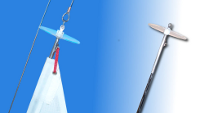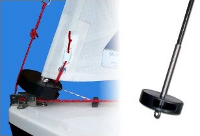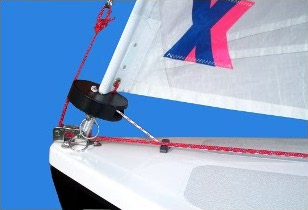The Aero Furling Spar - a complete furling reefing system
The Top Swivel and Bottom Drum of the Aero Furling Spar are incorporated within the composite carbon spar.
The luff wire passes through the hollow centre of the spar, with the swaged solid eye terminals at either end of the wire attached to the bow fitting and genoa halyard. The Top Swivel and Bottom Drum rotate on acetal bearings around the swaged solid eye terminals at either end of the luff wire. The luff wire and swaged solid eye terminals take all the load that is applied when tensioning the genoa halyard. With no loading applied to the drum and top swivel, (as is the case with all the separately bought systems), the spar is free to turn with virtually no frictional resistance. The lightweight (less than 0.5Kg), and compact (8mm diameter) spar provides an efficient aerodynamic entry shape for the genoa. The Aero Furling Spar is supplied complete with disc spacer to keep the forestay away from genoa luff. For Racing:
The Aero Furling Spar provides an efficient way of furling a genoa to save it from flogging - after rigging, launching, on the water, approaching landing, or in the dinghy park - without any loss of performance when racing. The low profile drum raises the foot of the genoa only 15mm higher than a standard luff wire thimble fitting. For Cruising:
A coupling can be used to raise the base of the furling drum sufficiently for it to be pivoted about the clevis pin, saving the need to detach the spar from the bow fitting when lowering the sail - which is necessary without this coupling.
When furling/reefing the sail in strong winds, it is advisable to sail off the wind to take the power out of the genoa for the few seconds that it takes to furl the genoa to the required size. General:
The Aero Spar, whilst having the flexibility to bend round into a wide U shape if held at either end, is a rigid material, and will break if bent round too far, particularly should the spar be left attached to the bow fitting and a point loading is applied around the middle of the spar to pull the top down under the spreaders. It is recommended that the furling drum is (manually) turned back a few turns after bringing the boat ashore, to ensure the genoa luff is not left tightly wrapped around the spar in the dinghy park.
|

The genoa peak is attached to the spar by a line tied between the sail and a fixed loop welded on the marine grade stainless steel end sleeve of the spar.
The Aero Furling Spar is supplied complete with disc spacer to keep the forestay away from genoa luff.

The genoa tack is secured to the furling drum by a line, with the luff tension being adjusted by means of a side cleat.
The genoa luff tension is not affected by tensioning the genoa halyard, since the sail is attached only to the spar and not the luff wire.

An optional coupling raises the height of the foot of the genoa by some 30mm - a feature probably not preferred by racers, but not usually any problem for day sailors and cruisers.

The coupling allows the spar to be lowered into the boat without needing to detach it from the bow fitting - as is necessary without it.
|